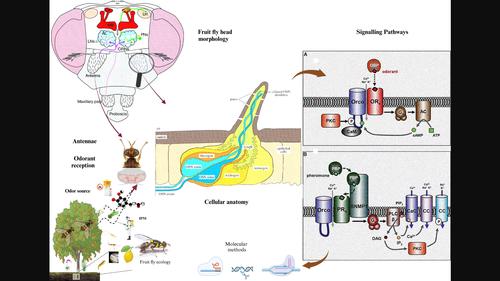当前位置:
X-MOL 学术
›
Physiol. Entomol.
›
论文详情
Our official English website, www.x-mol.net, welcomes your feedback! (Note: you will need to create a separate account there.)
Olfactory receptors in Bactrocera species for sustainable fruit fly management: A review and future perspectives用于果实蝇(Bactrocera spp)类害虫可持续管理的嗅觉受体:研究现状和未来展望
Physiological Entomology ( IF 1.5 ) Pub Date : 2024-01-24 , DOI: 10.1111/phen.12428 Saleem Jaffar 1 , Guy Smagghe 2, 3, 4 , Yongyue Lu 1
Physiological Entomology ( IF 1.5 ) Pub Date : 2024-01-24 , DOI: 10.1111/phen.12428 Saleem Jaffar 1 , Guy Smagghe 2, 3, 4 , Yongyue Lu 1
Affiliation

|
Molecular studies on odorant receptors (ORs), odorant-binding proteins (OBPs) and the functioning of the receptor and pheromone signal transduction in fruit fly Bactrocera species have expanded exponentially during the past few decades. OBPs contribute to the sensing of the olfactory system (OS) via the transduction of odorants through the sensillum lymph. However, ORs, a family of G-protein-coupled receptors in Bactrocera and various other species, exhibit heightened responsiveness to multiple chemical odours such as hormones, sensory stimuli and neurotransmitters. The apparent mechanism involves a combinatorial code encompassing both peripheral and antennal lobe processing, facilitating the reception of sexual pheromones and environmental cues. The OS is specifically designed to recognize and process information from volatile chemical signals, and these chemical signals play an important function in various flies. Insects rely on these chemicals to navigate and comprehend their surroundings. A mature insect OS is composed of two pairs of sensillae-covered palps, antennae and two primary pairs of olfactory appendages on the anterior head. It has been shown that chemosensory gene families contribute in odour perception. These include various neuroreceptor families, such as OBPs, chemosensory proteins and sensory neuron membrane proteins. Additionally, there are three divergent chemoreceptors, namely ORs, ionotropic receptors and gustatory receptors. Methods based on systematic biology, molecular biology and bioinformatics tools have rapidly emerged to investigate the insect communication systems and provide new insights for the management of many agricultural pest. Several aromatic compounds, including semiochemicals and pheromones, have been employed to defend crops and animals from destructive fruit flies and other invasive and frugivorous species. To promote the expansion of the cropping system, the utilization of phytochemical lures can be convenient for sustainable agriculture production and enhance food security. Hence, this review examined the state of the art in chemical communication of insects with a focus on fruit fly pest species to identify OS and their semiochemical receptors, protein receptors and chemosensory receptors (CSRs), as well as their practical applications for biological control and integrated pest management are highlighted.
中文翻译:

用于可持续果蝇管理的果实蝇物种的嗅觉受体:果实昆虫(Bactrocera spp)类害虫可持续管理的嗅觉受体的回顾和未来展望:研究现状和未来展望
在过去的几十年里,对果蝇果蝇气味受体(OR)、气味结合蛋白(OBP)以及受体功能和信息素信号转导的分子研究呈指数级增长。OBP 通过感器淋巴转导气味物质,有助于嗅觉系统 (OS) 的感知。然而,ORs(实蝇属和其他各种物种中的 G 蛋白偶联受体家族)对多种化学气味(例如激素、感觉刺激和神经递质)表现出高度的反应性。明显的机制涉及包含外周和触角叶处理的组合代码,促进性信息素和环境线索的接收。该操作系统专门用于识别和处理来自挥发性化学信号的信息,这些化学信号在各种果蝇中发挥着重要作用。昆虫依靠这些化学物质来导航和理解周围的环境。成熟的昆虫操作系统由两对覆盖感器的触须、触角和前头部的两对主要嗅觉附件组成。研究表明,化学感应基因家族有助于气味感知。这些包括各种神经受体家族,例如 OBP、化学感应蛋白和感觉神经元膜蛋白。此外,还存在三种不同的化学感受器,即 OR、离子型受体和味觉受体。基于系统生物学、分子生物学和生物信息学工具的方法迅速出现,用于研究昆虫通讯系统,并为许多农业害虫的管理提供新的见解。几种芳香化合物,包括化学信息素和信息素,已被用来保护农作物和动物免受破坏性果蝇和其他入侵和食果物种的侵害。为了促进种植系统的扩大,使用植物化学诱剂可以促进可持续农业生产并增强粮食安全。因此,本综述研究了昆虫化学通讯的最新技术,重点关注果蝇害虫物种,以识别 OS 及其化学信息受体、蛋白质受体和化学感应受体 (CSR),以及它们在生物防治和生物防治方面的实际应用。病虫害综合防治受到重视。
更新日期:2024-01-24
中文翻译:

用于可持续果蝇管理的果实蝇物种的嗅觉受体:果实昆虫(Bactrocera spp)类害虫可持续管理的嗅觉受体的回顾和未来展望:研究现状和未来展望
在过去的几十年里,对果蝇果蝇气味受体(OR)、气味结合蛋白(OBP)以及受体功能和信息素信号转导的分子研究呈指数级增长。OBP 通过感器淋巴转导气味物质,有助于嗅觉系统 (OS) 的感知。然而,ORs(实蝇属和其他各种物种中的 G 蛋白偶联受体家族)对多种化学气味(例如激素、感觉刺激和神经递质)表现出高度的反应性。明显的机制涉及包含外周和触角叶处理的组合代码,促进性信息素和环境线索的接收。该操作系统专门用于识别和处理来自挥发性化学信号的信息,这些化学信号在各种果蝇中发挥着重要作用。昆虫依靠这些化学物质来导航和理解周围的环境。成熟的昆虫操作系统由两对覆盖感器的触须、触角和前头部的两对主要嗅觉附件组成。研究表明,化学感应基因家族有助于气味感知。这些包括各种神经受体家族,例如 OBP、化学感应蛋白和感觉神经元膜蛋白。此外,还存在三种不同的化学感受器,即 OR、离子型受体和味觉受体。基于系统生物学、分子生物学和生物信息学工具的方法迅速出现,用于研究昆虫通讯系统,并为许多农业害虫的管理提供新的见解。几种芳香化合物,包括化学信息素和信息素,已被用来保护农作物和动物免受破坏性果蝇和其他入侵和食果物种的侵害。为了促进种植系统的扩大,使用植物化学诱剂可以促进可持续农业生产并增强粮食安全。因此,本综述研究了昆虫化学通讯的最新技术,重点关注果蝇害虫物种,以识别 OS 及其化学信息受体、蛋白质受体和化学感应受体 (CSR),以及它们在生物防治和生物防治方面的实际应用。病虫害综合防治受到重视。



























 京公网安备 11010802027423号
京公网安备 11010802027423号